- External26 May 2014
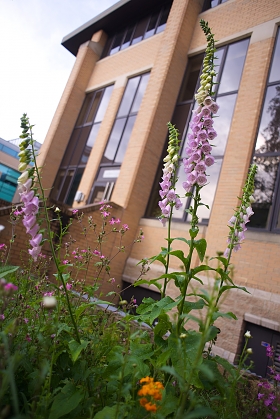
The Unit's wildflower meadow is blooming, and the Unit Oak is in leaf. This year we have several biennials flowering- the fox gloves giving impressive flower spikes in colours from pale pink to dark purple, and the teasels will stay standing after the purple flowers are gone, to provide seeds for birds such as goldfinches in the winter. The flowers have attracted a large number of bees, which seem to particularly like the red campion and fox gloves.
This year the Director's bird box was used by Great Tits– we had 9 eggs laid, all hatched on 28th April, and 5 fledged on the 17th May. Great tits would normally feed their young mainly on the green moth caterpillars that have a population boom in early May, but our birds were seen to be bringing a much larger number of spiders than you might expect, maybe due to a lack of trees in the area to support the moth larvae.
Below are two compilation videos- one from the box interior (we have a live feed from the box to a monitor in reception), showing the growth of the chicks; and the other an editted series of visits recorded from outside the box.
- Unit22 May 2014
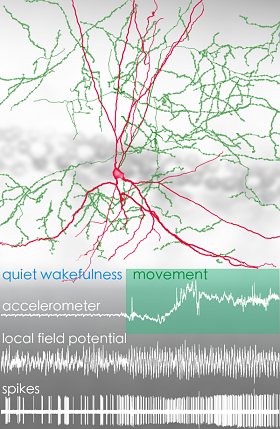 Bistratified cell in rat hippocampus. Reconstruction of the complete dendritic tree (red) and representative part of the axon (green) of a bistratified cell recorded and juxtacellularly labelled in the CA1 area of the hippocampus of a freely moving rat. Traces show the output of an accelerometer, the local field potential and filtered spikes, both recorded by the glass electrode. The cell increased its firing rate and changed to a more regular rhythmic firing pattern during transition from quiet wakefulness to movement.
Bistratified cell in rat hippocampus. Reconstruction of the complete dendritic tree (red) and representative part of the axon (green) of a bistratified cell recorded and juxtacellularly labelled in the CA1 area of the hippocampus of a freely moving rat. Traces show the output of an accelerometer, the local field potential and filtered spikes, both recorded by the glass electrode. The cell increased its firing rate and changed to a more regular rhythmic firing pattern during transition from quiet wakefulness to movement.Neuropeptides and GABA are co-expressed and co-released by hippocampal interneurons. Bistratified and O-LM cells innervate segregated dendritic domains of pyramidal cells and co-release GABA and somatostatin acting on pre- and postsynaptic receptors. How do the activity patterns of these peptidergic/GABAergic interneurons support behaviour? Katona et al. recorded, labelled and identified individual interneurons in freely-moving rats and investigated their firing activity during movement and sleep in relation to hippocampal network oscillations. They found that behavioural and network states differentiate the firing of somatostatin-expressing bistratified and O-LM interneurons in the hippocampus. During movement, the two cell types cooperate temporally, firing at the trough of theta oscillatory cycles but at different frequencies. In contrast, during sleep, the two cell types dissociate in their function; bistratified cells are strongly active while O-LM cells decrease firing.
The results suggest that segregated glutamatergic inputs to CA1 pyramidal cell dendrites from the entorhinal cortex and the CA3 area are differentially modulated by GABA and somatostatin during behaviour.
- External11 May 2014
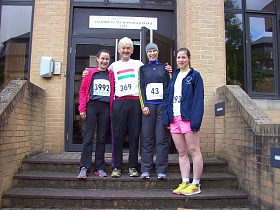
A dwindling number of determined sporty types from the Unit braved the 10 km Town and Gown charity run supporting the Muscular Distrophy Campaign
Kristina Detzner (52:11) and Kathryn Newton (54:17) both improved on their previous times, and new runner Anna-Kristin Kaufmann (1:09:36) did well in her first race, while Director Peter Somogyi (54:59) paid the price of the Unit’s ongoing quinquennial MRC review and was down on last year by 1 min 34 seconds. Nevertheless he improved his age adjusted grading, proving yet again how good vintage improves with age. This year 3,265 runners finished and watched in awe as David Bruce (32:02) won the 33rd race of this annual event. From the team of The MAGYARS, daughter Lilla came in fastest at 46:12, son Levente and fiancé Beata Turik finished hand in hand at 59:56.
- Unit5 May 2014
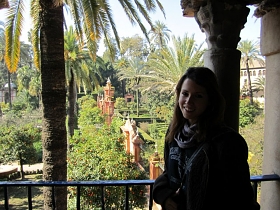
Sara graduated in Physics at the University of Barcelona, Spain, in 2009. Sara then stayed on at the University of Barcelona to complete her Masters degree in Biophysics (2010), during which she undertook her final research project in the Neurophysics Laboratory led by Dr. Jordi Soriano. She is currently pursuing her PhD in the same place, with Dr. Jordi Soriano as her thesis advisor. Her PhD project is focused on the characterization of activity dynamics and functional network connectivity within clustered neuronal cultures.
Sara joins the Unit for one month (5 May - 5 June) in order to learn new experimental techniques that she can apply to characterising the structural map of connections in her neuronal cultures, as a collaboration with Unit scientist Dr. Juan Mena-Segovia in the Bolam Group.
- Unit2 May 2014
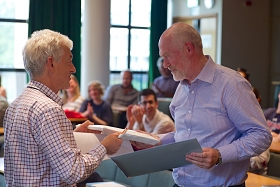
On the 2nd May, we celebrated Dr. Jeff McIlhinney’s retirement from the Unit with an afternoon of talks, including some from Jeff's previous post-docs, collaborators and students. The talks were light-hearted experiences on working with Jeff.
Jeff joined the MRC Anatomical Neuropharmacology Unit at the Department of Pharmacology in 1986. His research has concentrated on the study of the structure, synthesis, cell-surface targeting and trafficking of neurotransmitter receptors in the central nervous system. This has involved meticulous study of the assembly and intracellular trafficking of the N-methyl-D-aspartate (NMDA) class of ionotropic glutamate receptors, as well as the role of dimerization and interacting proteins on the cell-surface expression and neuronal trafficking of metabotropic glutamate receptors (mGluRs). Jeff's group also collaborated with Glaxo-Wellcome on the role of interacting proteins in the intracellular trafficking and signalling of GABA-B receptors.
Jeff delivered 28 years of outstanding service as a scientist, mentor and collaborator, and will be greatly missed by everyone in the Unit. We wish him a long and happy retirement! - Unit30 Apr 2014
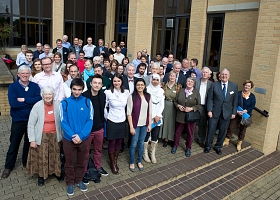
On the 24th April 2014 a Symposium was held to celebrate the 20th Anniversary of the Blaschko Fellowships, and the life of Hugh Blaschko, FRS. The Symposium opened with an introduction by Professor Peter Somogyi: “20 years of The Hugh Blaschko European Research Fellowship”, followed by talks from Professor David Smith: “Hugh Blaschko: the man and the scientist”, Professor Hans Winkler (University of Innsbruck): “Looking back as a pharmacologist: Hugh Blaschko, chromaffin granules and drug markets”, and Professor Les Iversen, FRS: “Novel psychoactive drugs: Applied monoamine pharmacology”.
Eight previous Blaschko Scholars were present, from the earliest award (1994-1995) to the present, and talks were given by Drs Laura Conforti, Leah Herregen, Eef Hogervorst, Amy Pooler, Gabor Tamas, and the current Fellow, Gunes Unal.
The symposium was held in conjunction with the 10th David Smith Lecture in Anatomical Neuropharmacology. The speaker was Professor Zoltan Nusser, Institute of Experimental Medicine of the Hungarian Academy of Sciences, Budapest, who gave the lecture “Molecular, functional and structural heterogeneity of central synapses”. The lecture also celebrated the founding of the MRC Unit 30 years ago, with the arrival of the memorial stone from Scotland placed next to the Unit Oak.
The day was concluded by Professor Antony Galione, Head of the Department of Pharmacology, and was followed by a celebratory dinner hosted by Linacre College for speakers and guests including HE Peter Szabadhegy, the Hungarian Ambassador to the UK, Dr Ruth Baker and HH Judge Ann Campbell (Trustees of the Blaschko Research Scholarship), Sir Bryan Cartledge, Principal of Linacre College (1988) as well as the current Principal, Nick Brown.
- Unit29 Apr 2014
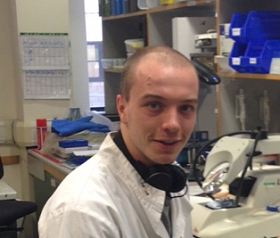 Tommy Gill, Oxford FHS undergraduate student
Tommy Gill, Oxford FHS undergraduate studentWe are pleased to welcome Mr. Thomas Gill to the Unit. Tommy is an undergraduate student studying for his Biomedical Sciences degree at Corpus Christi College, Oxford, and has joined the Magill Group to undertake his Final Honours School research project. Tommy is working with Farid Garas and Andy Sharott, and is using light microscopy, immunofluorescence labelling and stereology to define the molecular architecture of interneurons in the ventral striatum.
- Unit29 Apr 2014
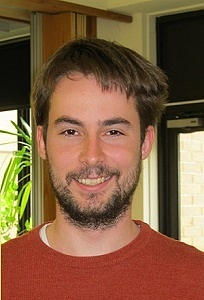
Yves Weissenberger joins the Group of Dr. David Dupret for his second lab rotation as an MSc Neuroscience student at Oxford University. Working with Dr. Alvaro Tejero-Cantero, Yves will use multi-site electrophysiology as well as computational modelling to investigate how distributed neural circuits in the mouse brain interact to enable reward-driven learning about spatial environments. Yves received a BA in Physiological Sciences from Oxford University, where he previously studied how the brain solves correspondence problems in vision.
- Unit28 Apr 2014
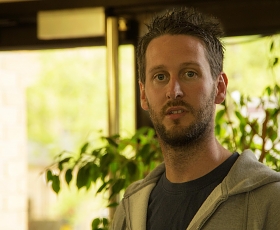
We are pleased to welcome Dr. Lucas Black to the Unit as our new Imaging Research Scientist.
Lucas graduated from Heriot-Watt University, Edinburgh, with a B.Sc. in Marine Biotechnology. Before starting his PhD, Lucas worked as a research technician at the University of Edinburgh, using fluorescent probes to quantify gene expression in response to growth rates. In 2007, Lucas started his PhD with Dr. Rosalind Allen at the University of Edinburgh, carrying out research into the pressure adaptation of deep-sea bacteria; this work involved the construction and testing of high-pressure microscopy equipment.
In 2010, following on from his PhD, Lucas moved to Montpellier, France, to use quantitative microscopy techniques (FCS, FCCS and RICS) to directly measure the gene response of bacteria to changes in environmental conditions. In a second international move, Lucas returned to the country of his birth, South Africa, to take up the Lead PostDoc position on an international project to isolate and identify novel bioactive drug-candidate molecules.
Lucas will be working closely with members of the Bolam Group and Magill Group, as well as providing imaging support for other Unit programmes.
- Unit28 Apr 2014
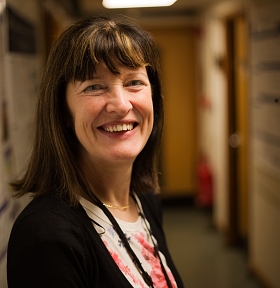
We are pleased to welcome Jane Janson to the Unit.
Jane started her career at Nottingham University in 1990, working for the Cancer Studies Unit, and then spent 18 months working with Renasci, an organisation interested in type II diabetes. In 2006, she joined Prof. Sue Watson in a spin-out company from the University of Nottingham.
Jane joins Liz to help run the Unit's Central Services.